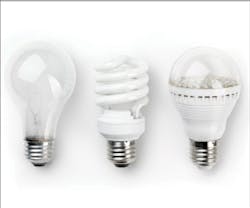Quicker paybacks, adaptable components, and greater indoor applicability are within sight for LED lighting systems, industry experts say. The energy-efficient technology has made great strides in price, lifecycle, and color quality in recent years and will soon be ready for prime time, indoors and outdoors.
The State of the Industry
LEDs in outdoor lighting and downlighting are still outpacing indoor applications, according to Dave Ranieri, vice president and general manager of Lithonia Lighting’s fluorescent and LED business unit. The technology is especially popular for outdoor uses because in addition to energy savings, LEDs’ long life means fewer replacement hassles, an appealing prospect for hard-to-reach fixtures.
LEDs’ growing popularity for downlighting is mainly due to a quick return on investment, Ranieri adds.
“A lot of sources used for downlighting are less efficient,” he explains. “An incandescent source or even a compact fluorescent are not nearly as efficient, so it makes sense to convert them sooner.”
Current innovation efforts focus mainly on increasing lumens, better controlling brightness and intensity, managing heat, and providing more consistent color quality, Ranieri says. Some companies opt to focus on finding uses for LEDs in new computer-based applications, such as specifying automatic color rendition changes for certain periods of the year, says Kevin Button, president and cofounder of lighting consulting firm LED Lighting Solutions.
“Everybody is getting involved with LED. It’s like the dot-com era,” Button says. “People are coming out with more and more technology to make it brighter, but it’s a computer-based lighting system, so the capabilities are endless.”
Clearing the Efficiency Hurdles
Increasing the efficiency of the already highly efficient technology tops the list, especially for commercial indoor applications, Ranieri says.
“T8s and T5s are very efficient, and they represent a high hurdle in terms of efficiency and maintenance,” he explains. “LEDs are starting to make a serious run at T5 and T8 fluorescents.”
Achieving this goal will allow manufacturers and luminaire designers to devise more retrofit-friendly products for interiors, Ranieri says. “Up until this last year, you could design a luminaire with LEDs in it, but you couldn’t get as many lumens out of it as you can with a fluorescent. Then you have a hard choice to make – settle for less light or put more fixtures in. Both of those are bad choices.”
Button points to EvoLucia, a provider of custom LED lighting solutions, as an example of industry innovation: “They said, ‘We’re going to settle for what’s out there as far as lumens per watt, but we’re going to find a way for LEDs to be positioned for a greater spread of light.’ It’s doing more for you than being brighter.”
What’s Next?
“What we’re starting to do now is optimizing the whole design around the LEDs thermally, optically, mechanically, and aesthetically,” Ranieri says. “The other thing is the idea of merging LEDs with controls because now you’ve got a digital light source that can do so much more. You can very easily add intelligence into the light fixture.”
That potential for intelligent behavior and the plummeting price will drive many of the coming innovations, he adds. Optics continue to improve, and luminaire design is likely to change drastically – as Ranieri puts it, “They’re going to look radically different in 2 to 3 years.”
“They can be preprogrammed to lower cost and light output. You can configure them so they can be easily networked and paired with lower-cost controls. You can do plug-and-play controls that are easier to install, operate, and change if you want to reconfigure a space,” Ranieri explains. “You can do all kinds of cool things, but the biggest thing is simplicity.”
Brightness and color rendition are finally adequate, and heat generation isn’t a problem if the product has an appropriately-sized heat sink, Button adds.
“I think we’ve really gotten to a point where it’s all there,” Button says. “The one thing we’re lacking now is education. It’s about how it’s made and how it’s put together. If you know what you’re doing, it’s an easy thing. If you don’t, that’s when you have a huge issue.”
About the Author
Janelle Penny
Editor-in-Chief at BUILDINGS
Janelle Penny has been with BUILDINGS since 2010. She is a two-time FOLIO: Eddie award winner who aims to deliver practical, actionable content for building owners and facilities professionals.

